The Cheese Cutting Machine Market is estimated to be valued at USD 14661.5 million in 2025 and is projected to reach USD 29112.0 million by 2035, registering a compound annual growth rate (CAGR) of 7.1% over the forecast period.
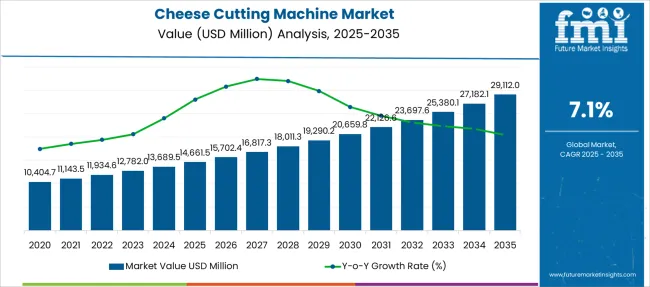
| Metric | Value |
|---|---|
| Cheese Cutting Machine Market Estimated Value in (2025 E) | USD 14661.5 million |
| Cheese Cutting Machine Market Forecast Value in (2035 F) | USD 29112.0 million |
| Forecast CAGR (2025 to 2035) | 7.1% |
The cheese cutting machine market is expanding steadily, driven by growing demand for precision, hygiene, and automation in dairy processing. As global consumption of packaged cheese continues to rise, food manufacturers and retailers are adopting advanced cutting equipment that ensures uniformity, reduces wastage, and complies with food safety standards.
The emphasis on production efficiency and consistent slicing in large-scale dairy operations is accelerating the integration of automated systems. In addition, the surge in artisanal and specialty cheese varieties has created the need for machines capable of handling different textures and formats without compromising quality.
Increasing urbanization and growth in cold chain logistics are also facilitating broader distribution, fueling demand for technologically advanced cutting solutions. Looking ahead, the market is expected to benefit from continuous innovations in blade technology, adjustable formats, and energy-efficient machines that address evolving operational and retail requirements.
The market is segmented by Product type, End Use, and Distribution Channel and region. By Product type, the market is divided into Horizontal and Vertical. In terms of End Use, the market is classified into Supermarkets, Restaurants, and Dining rooms. Based on Distribution Channel, the market is segmented into Online and Offline. Regionally, the market is classified into North America, Latin America, Western Europe, Eastern Europe, Balkan & Baltic Countries, Russia & Belarus, Central Asia, East Asia, South Asia & Pacific, and the Middle East & Africa.
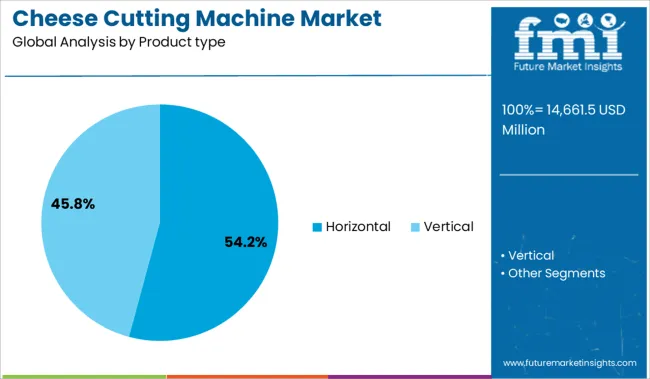
The horizontal segment is projected to account for 54.20% of total revenue by 2025 within the product type category, establishing itself as the leading segment. This is primarily due to its suitability for high-volume cheese processing lines where precision and speed are essential.
Horizontal machines enable consistent slicing across uniform layers, making them ideal for packaging and retail display formats. Their compatibility with automated workflows and ability to handle various cheese densities without structural compromise have enhanced adoption.
The segment also benefits from lower product wastage and higher throughput, which aligns with both industrial efficiency goals and sustainability initiatives. As manufacturers prioritize cost-effective, clean-cut solutions, horizontal machines continue to dominate the product type landscape.
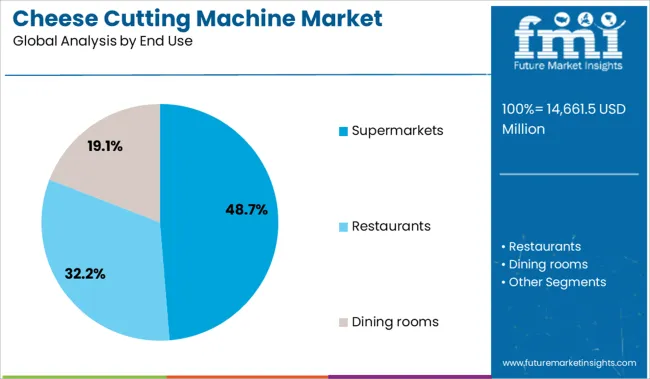
The supermarkets segment is expected to contribute 48.70% of market revenue by 2025 within the end use category. The growing demand for pre-sliced and pre-packaged cheese in retail environments has led to increased reliance on cutting machines that ensure consistent portion sizes and visual appeal.
Supermarkets require equipment that balances speed with quality, especially for ready-to-sell cheese products across deli counters and packaged shelves. The shift toward self-service and grab-and-go dairy options has also encouraged investment in in-store slicing infrastructure.
Additionally, retail chains are optimizing supply chains with centralized processing facilities that use high-capacity cutting machines to meet volume demands. These trends have positioned supermarkets as the dominant end use sector in the market.
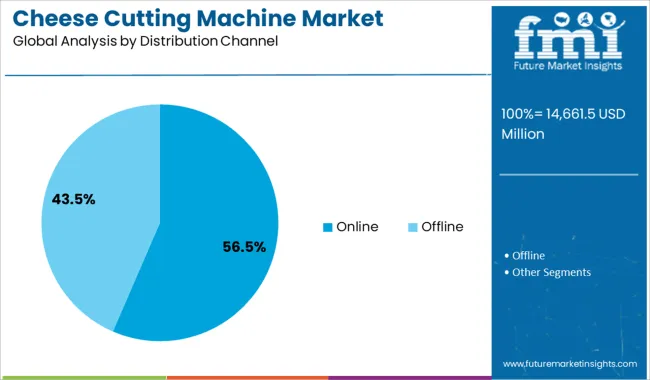
The online distribution channel is projected to hold 56.50% of the market share by 2025, leading the distribution channel category. This shift is driven by the increasing digitalization of procurement processes and the availability of a wide range of cheese cutting machines on e-commerce platforms.
Buyers are leveraging online channels for cost comparisons, product customization, and access to technical specifications without the need for intermediary distributors. Manufacturers are also expanding their digital presence to offer direct-to-customer sales, training videos, and virtual product demos.
Enhanced logistics and fast delivery mechanisms have further supported this growth. As commercial kitchens, retailers, and foodservice operators increasingly prioritize convenience and transparency in procurement, the online segment continues to gain market leadership.
The cheese cutting machine market worldwide expanded at a CAGR of 5.8% between 2020 and 2025.
Hot cheese, flavored brie, clothbound cheddar, gruyere's cousins, gjetost, zany cheese pairings, marinated fresh cheese, and cheese with a side of butter are all examples of emerging cheese market trends that could affect the adoption of cheese cutting machines.
According to Future Market Insights, the global cheese cutting machine market is expected to expand at a CAGR of 7.1% during the forecast period.
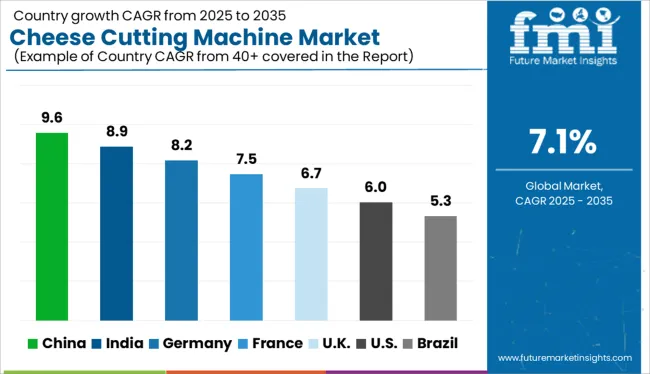
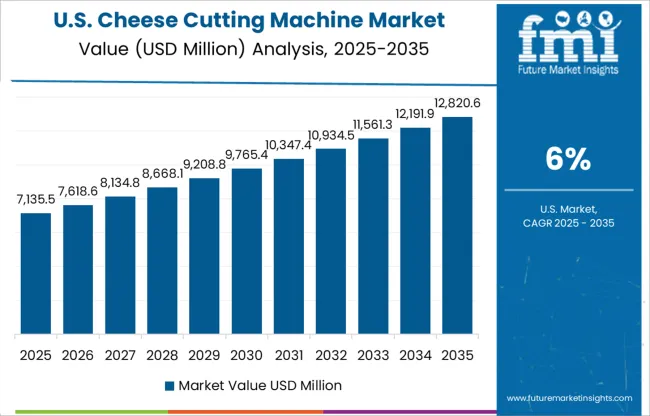
The United States holds the largest cheese cutting machine market share. The major factors driving the demand for industrial cheese shredders in the USA are:
The perishable nature of cheese products and unhealthy additives/ingredients in processed cheese are two significant factors that limit the expansion of the USA cheese cutting machine market.
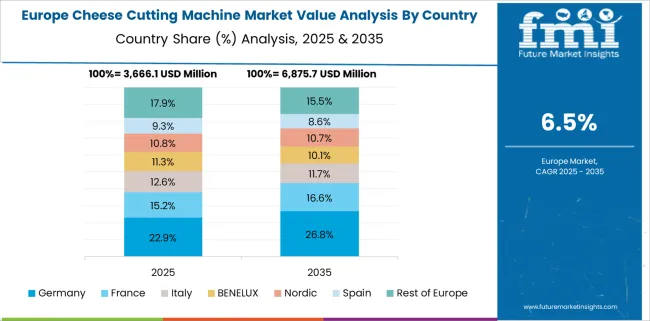
Cheese is a staple in European cuisine. Some key statistics navigating the demand for industrial cheese shredders in Europe are:
In recent years, the demand for cheese cutting machines in the United Kingdom market has grown significantly. This is because more and more people are realizing the benefits of using these machines.
With the increase in demand, there has also been an increase in the number of companies that manufacture paneer cutting machines. This has resulted in a wide range of models and prices to choose from.
In 2025, sales of cheese cutting machines in Korea are expected to reach USD 14661.5 billion. There is anticipated to be an annual growth rate of 5.85% in the market (CAGR 2025 to 2035).
The rising disposable incomes and growing population are the major factors driving the growth of the cheese cutting machine market in Korea. Furthermore, people's changing lifestyles and the expanding food service industry are both contributing to the rising demand for cheese cutting machines in the country.
The major players in this market are GEA Group, Tetra Pak International S.A., Krones AG, Suzano S.A., and Buhler AG, all of which are focusing on expanding their product portfolios and geographical presence in order to gain a competitive advantage.
Japan is currently the leading cheese cutting machine market, with sales increasing year on year. There are several reasons for this, including the strong dairy industry in Japan and the growing popularity of cheese as a foodstuff.
According to data gathered by the Ministry of Agriculture, Forestry, and Fisheries in the fiscal year 2024, total cheese consumption in Japan was 360,744 tonnes.
Commercial demand for cheese, such as in restaurants and in the production of confectionery products, dropped significantly as a result of the pandemic. However, with the continued trend toward more Western-style food and people becoming more health-conscious, cheese has become a more common fixture on American dinner tables.
Nearly two-thirds of all cheese eaten was natural, and the vast majority of that was imported (88%). Australia supplied Japan with the most cheese imports in 2024. After that came Germany, the Netherlands, the United States, and New Zealand.
The Japanese dairy industry is one of the most efficient in the world, and this is reflected in the high quality of cheese produced. Japanese cheesemakers are constantly innovating and developing new types of cheese, which has helped to increase demand for cheese cutting machines.
In addition, the growing popularity of cheese as a foodstuff means that more and more people are looking for ways to incorporate it into their diets. Cheese block cutters offer an easy and convenient way to do this, and as such, they have become increasingly popular in Japan.
In 2025, the continuous product segment of the cheese cutting machine market is expected to account for a larger percentage of the market than any other segment. Due to their capacity to reliably slice big blocks of cheese into uniformly sized cubes, these machines have become rather popular. These devices are in high demand since they are simple to use and need little upkeep.
Other factors that are predicted to contribute to the continuous product segment’s expansion include the growing demand for processed cheese and the increased focus on health among consumers. Due to its increased shelf life and delicious flavor, processed cheese is widely utilized in a variety of food preparations, including snacks, sandwiches, pizzas, and burgers.
Restaurants always must make more cheese because people want to eat it. Cafes and restaurants need efficient cheese-cutting methods if they are to keep up with the demand. Cutting machines aid them in their quest to slice cheese. In a short amount of time, these machines can slice a whole block of cheese into tiny slices. This helps minimize waste while simultaneously saving time. The use of a cheese block cutter allows restaurants to meet customer demands without worrying about running out of cheese.
The expanding restaurant sector is driving demand for cheese cutting machines. Faster and more precise cheese slicing is now possible because of these machines' widespread use in restaurants. As a result, restaurants can save money while cheese-cutting equipment makers see increased revenues.

The market for cheese cutting machines is projected to expand at a CAGR of 7.1% between 2025 and 2035. The market is extremely competitive due to a large number of existing companies. The leading companies in this sector include Robert Bosch GmbH, GEA Group, tetra Pak International SA, JBT Corporation, and Krones AG.
Typically, cheese block cutters are either horizontal or vertical, depending on the manufacturer's preference. The horizontal sector is anticipated to expand at a rapid clip over the projection period. The expansion of this market segment can be ascribed to the rising need for these kinds of equipment in the food and beverage sector.
Growth in the cheese block cutters industry is anticipated to skyrocket in the next years. The expanding food business is largely responsible for this rise in the market for such equipment. The primary markets for cheese block cutters are commercial kitchens, restaurants, and hotels. As cheese's popularity grows in these areas, the demand for cheese cutting machines is likely to expand.
| Attributes | Details |
|---|---|
| Forecast period | 2025 to 2035 |
| Historical data available for | 2020 to 2025 |
| Market analysis | USD million in value |
| Key regions covered | North America; Latin America; Western Europe; Eastern Europe; Middle east and Africa; Asia Pacific |
| Key countries covered | USA, Germany, France, Italy, Canada, United Kingdom, Spain, China, India |
| Key segments covered | Product, Application, Distribution channel, Region, Source |
| Key companies profiled | GEA Group, Multivac; RISCO GmbH; Industries Castellvall; Provisur Technologies; iXAPACK; Food Tools; Textor Maschinenbau GmbH; Thurne-Middleby; Marchant Schmidt |
| Report Coverage | Market Forecast, Company Share Analysis, Competitive Landscape, DROT Analysis, Market Dynamics, Challenges, Strategic Growth Initiatives |
| Customization and Pricing |
Available upon request |
The global cheese cutting machine market is estimated to be valued at USD 14,661.5 million in 2025.
The market size for the cheese cutting machine market is projected to reach USD 29,112.0 million by 2035.
The cheese cutting machine market is expected to grow at a 7.1% CAGR between 2025 and 2035.
The key product types in cheese cutting machine market are horizontal and vertical.
In terms of end use, supermarkets segment to command 48.7% share in the cheese cutting machine market in 2025.






Full Research Suite comprises of:
Market outlook & trends analysis
Interviews & case studies
Strategic recommendations
Vendor profiles & capabilities analysis
5-year forecasts
8 regions and 60+ country-level data splits
Market segment data splits
12 months of continuous data updates
DELIVERED AS:
PDF EXCEL ONLINE
Cheese Packaging Market Forecast and Outlook 2025 to 2035
Cheese Concentrates Market Size and Share Forecast Outlook 2025 to 2035
Cheese Ingredient Market Size and Share Forecast Outlook 2025 to 2035
Cheese Color Market Size and Share Forecast Outlook 2025 to 2035
Cheese Market Size and Share Forecast Outlook 2025 to 2035
Cheese Flavor Market Size, Growth, and Forecast for 2025 to 2035
Cheese Market Analysis - Size, Share, and Forecast Outlook 2025 to 2035
Cheese Powder Market Size, Growth, and Forecast for 2025 to 2035
Cheese Alternatives Market Analysis - Size, Share, and Forecast 2025 to 2035
Cheese Analogue Market Insights - Growth & Demand Analysis 2025 to 2035
Cheese Liners Market
Vegan Cheese Market Size and Share Forecast Outlook 2025 to 2035
Cream Cheese Market Analysis – Size, Share, and Forecast 2025 to 2035
Vegan Cheese Sauce Market Size and Share Forecast Outlook 2025 to 2035
Nacho Cheese Warmers Market – Hot & Fresh Cheese Dispensing 2025 to 2035
Spray Cheese Market Analysis by Flavours, Distribution Channel and Region through 2035
Analysis and Growth Projections for Halal Cheese Market
Frozen Cheese Market Size and Share Forecast Outlook 2025 to 2035
Understanding Market Share Trends in String Cheese Production
Smoked Cheese Market

Thank you!
You will receive an email from our Business Development Manager. Please be sure to check your SPAM/JUNK folder too.
Chat With
MaRIA